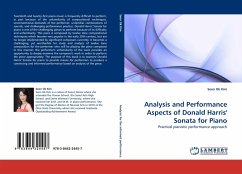
Analysis and Performance Aspects of Donald Harris'' Sonata for Piano
Practical pianistic performance approach
Versandkostenfrei!
Versandfertig in 6-10 Tagen
39,99 €
inkl. MwSt.

PAYBACK Punkte
20 °P sammeln!
Twentieth and twenty-first piano music is frequently difficult to perform, in part because of the unfamiliarity of compositional techniques, unconventional demands of the performer, unfamiliar combinations of sounds, and challenging performance practice. Donald Harris' Sonata for piano is one of the challenging pieces to perform because of its difficulty and unfamiliarity. This piece is composed by twelve tone compositional techniques which became very popular in the early 20th century, but are no longer implemented by significant composers currently. It becomes a challenging, yet worthwhile f...
Twentieth and twenty-first piano music is frequently difficult to perform, in part because of the unfamiliarity of compositional techniques, unconventional demands of the performer, unfamiliar combinations of sounds, and challenging performance practice. Donald Harris' Sonata for piano is one of the challenging pieces to perform because of its difficulty and unfamiliarity. This piece is composed by twelve tone compositional techniques which became very popular in the early 20th century, but are no longer implemented by significant composers currently. It becomes a challenging, yet worthwhile for study and analysis of twelve tone composition for the performer who will be playing the piece composed in this manner; the performer's unfamiliarity of the work provides an opportunity to deeply examine the composer's work in order to perform the piece appropriately. The purpose of this book is to examine Donald Harris' Sonata for piano to provide means for performers to produce a convincing and informed performance based on analysis of the piece.












